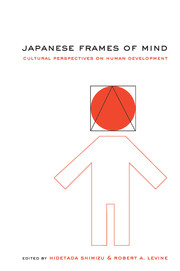Book contents
- Frontmatter
- Contents
- Notes on the Contributors
- Preface: Japan as Front Line in the Cultural Psychology Wars
- Introduction: Japanese Cultural Psychology and Empathic Understanding: Implications for Academic and Cultural Psychology
- PART ONE MORAL SCRIPTS AND REASONING
- PART TWO MOTHER AND CHILD AT HOME
- PART THREE GROUP LIFE: THE YOUNG CHILD IN PRESCHOOL AND SCHOOL
- PART FOUR ADOLESCENT EXPERIENCE
- 7 Beyond Individualism and Sociocentrism: An Ontological Analysis of the Opposing Elements in Personal Experiences of Japanese Adolescents
- 8 Returnees to Japan: The Impact of Having Lived in the United States
- PART FIVE REFLECTIONS
- Index
7 - Beyond Individualism and Sociocentrism: An Ontological Analysis of the Opposing Elements in Personal Experiences of Japanese Adolescents
Published online by Cambridge University Press: 23 July 2009
- Frontmatter
- Contents
- Notes on the Contributors
- Preface: Japan as Front Line in the Cultural Psychology Wars
- Introduction: Japanese Cultural Psychology and Empathic Understanding: Implications for Academic and Cultural Psychology
- PART ONE MORAL SCRIPTS AND REASONING
- PART TWO MOTHER AND CHILD AT HOME
- PART THREE GROUP LIFE: THE YOUNG CHILD IN PRESCHOOL AND SCHOOL
- PART FOUR ADOLESCENT EXPERIENCE
- 7 Beyond Individualism and Sociocentrism: An Ontological Analysis of the Opposing Elements in Personal Experiences of Japanese Adolescents
- 8 Returnees to Japan: The Impact of Having Lived in the United States
- PART FIVE REFLECTIONS
- Index
Summary
In recent years, cultural psychologists have emphasized the contrast between the individualistic premises of American psychology and the sociocentric orientation of non-Western indigenous psychology (Markus & Kitayama, 1991; Marsella, DeVos, & Hsu, 1985; Shweder & Bourne, 1984). Generally, the discussion focuses on the proposed, individually self-contained, and self-transcendent aspects of Western selfhood (Geertz, 1983), and its interpersonally contextual and “other-oriented” (collective, empathic, etc.) counterparts, particularly in India (Dumont, 1970; Shweder & Bourne, 1984) and Japan (Markus & Kitayama, 1991). Others have pointed out methodological and conceptual limitations of an attempt to link directly the two dichotomized essences to the aspects of self that are characteristically psychological and hence less accessible to direct observation and measurement, and to generalize the dichotomy to groups with large populations such as Japanese or East Asians who are contrasted with Westerners (Kusserow, 1999; Lindholm, 1997; Murray, 1993; Spiro, 1993).
Japan provides a particularly illuminating context for this debate. Nearly a half century ago, Ruth Benedict (1946) argued that fear of being shamed in interpersonal relationships (hito ni hazukashii) was the main cultural configuration of Japanese behavior, personality, and socialization. Others who followed Benedict's footsteps two decades later elaborated her interpersonal framework of analysis (e.g., Lebra, 1976; Nakane, 1970). Some Japanese scholars extended it as a conceptual basis of their nihonjinron, a “theory” of Japanese people's uniqueness (e.g., Aida, 1970; Doi, 1977; Hamaguchi, 1977; Kimura, 1972).
- Type
- Chapter
- Information
- Japanese Frames of MindCultural Perspectives on Human Development, pp. 205 - 227Publisher: Cambridge University PressPrint publication year: 2002
- 4
- Cited by

